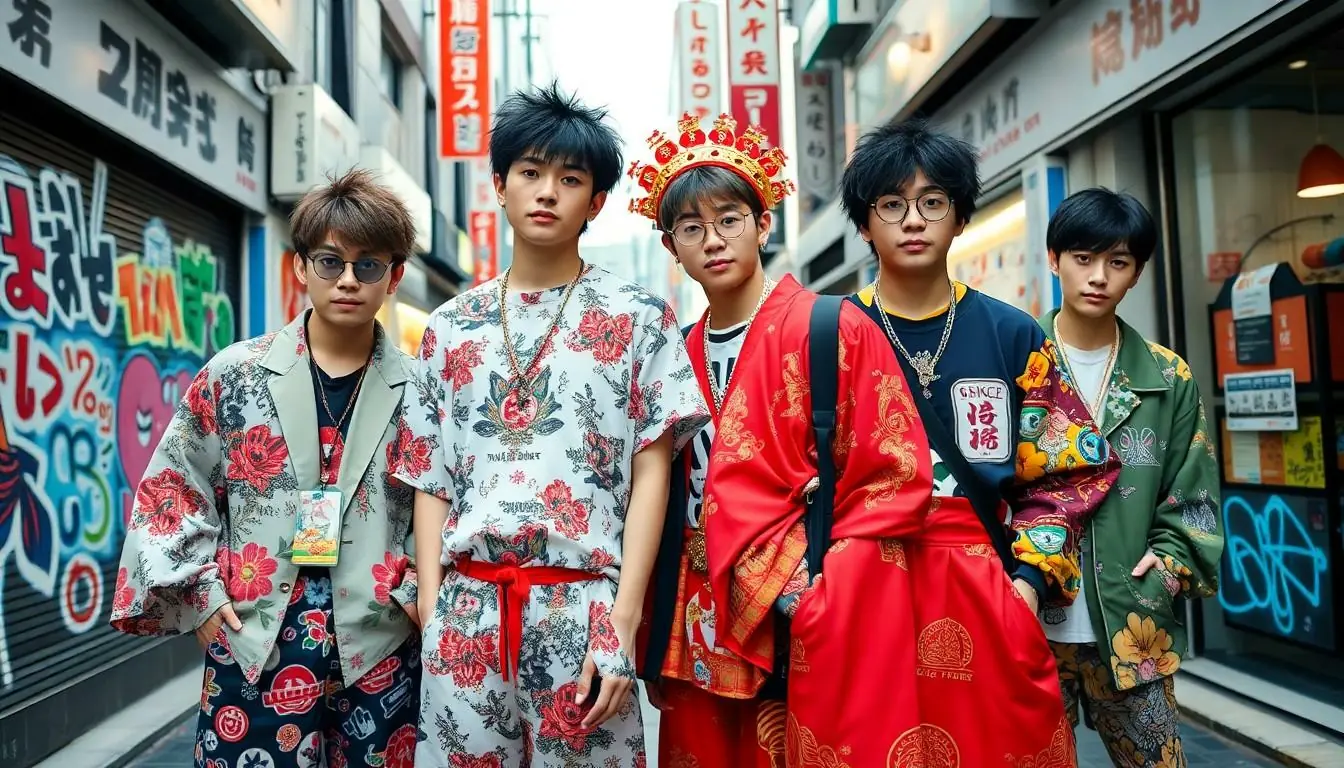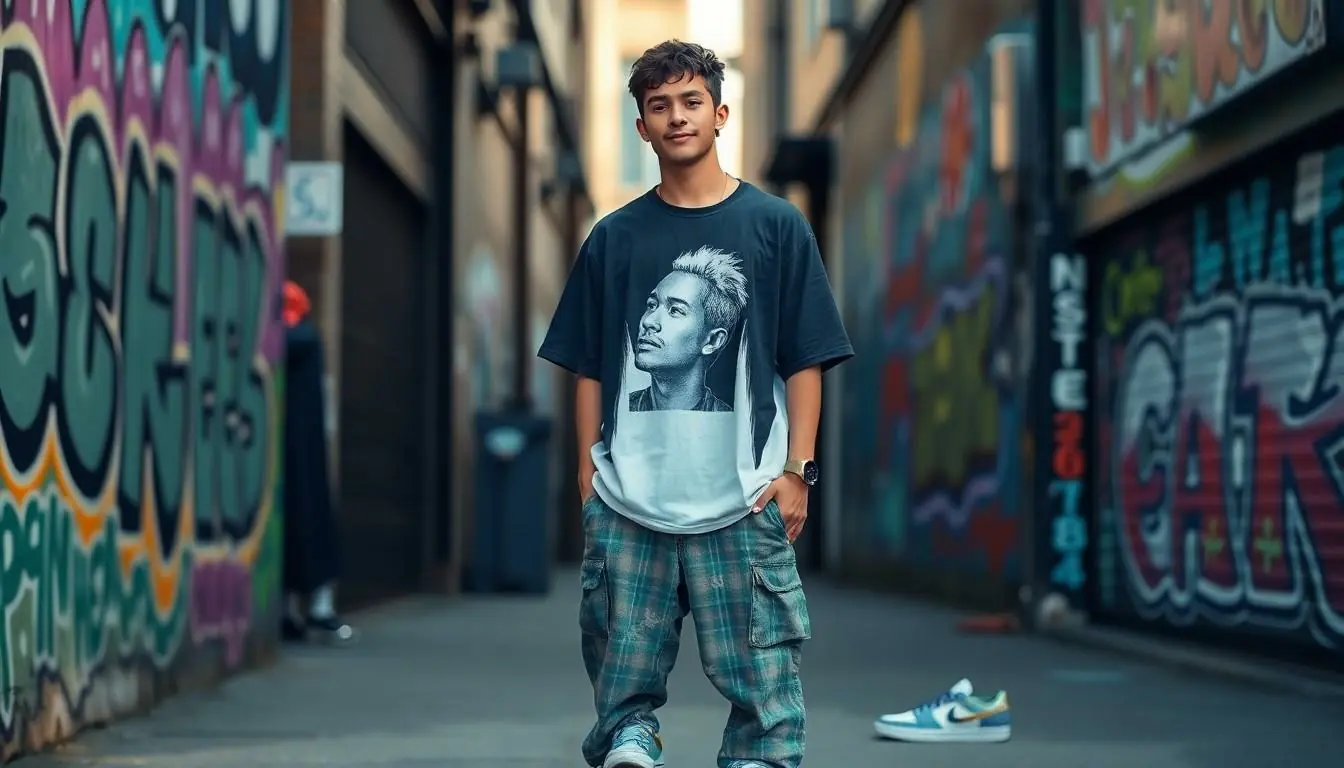Table of Contents
ToggleJapanese streetwear isn’t just a fashion statement; it’s a cultural phenomenon that’s taken the world by storm. Picture this: oversized hoodies, vibrant graphic tees, and sneakers that make even the most casual observer do a double-take. For men looking to elevate their style game, diving into the realm of Japanese streetwear offers an exciting blend of creativity and individuality.
Overview of Japanese Streetwear Men
Japanese streetwear embodies a unique blend of style, art, and culture. Men often showcase a strong sense of individuality through bold designs and eclectic ensembles. Oversized silhouettes remain popular, providing comfort while making a fashion statement. Graphic tees, featuring intricate artwork, serve as a canvas for artistic expression.
Incorporating accessories enhances the overall look. Caps and beanies add a casual flair, while unique sneakers give an edge. Brands like Comme des Garçons, A Bathing Ape, and Neighborhood illustrate the diversity within the market. Each label offers distinctive pieces that cater to various preferences.
Cultural influences play a significant role in shaping this style. Traditional Japanese aesthetics often merge with contemporary street vibes. Layering allows for creative combinations, emphasizing personal style. Patterns, such as kanji characters or anime graphics, frequently appear in designs, fostering a connection to heritage.
Streetwear events and pop-up shops create vibrant communities. These gatherings allow enthusiasts to explore new trends and exchange ideas. Social media platforms also contribute to the spread of Japanese streetwear, inspiring global audiences. Engaging with influencers and artists on these platforms highlights emerging trends.
Japanese streetwear continues to evolve, maintaining relevance in the fashion landscape. Men exploring this style find room for innovation and creativity. As this movement progresses, it urges onlookers to appreciate craftsmanship and cultural narratives interwoven in each piece.
Key Influences on Japanese Streetwear

Japanese streetwear draws from various historical and cultural influences that shape its distinct identity. Significant roots exist in both traditional elements and contemporary scene.
Historical Context
Post-World War II, Japan saw a surge in Western influence, particularly in fashion. Designers adapted western styles to create new trends, combining them with local aesthetics. The 1980s brought forth a youth subculture that embraced individuality through clothing. Harajuku emerged as a hotspot, where eclectic fashion flourished, allowing diverse styles to mix. Streetwear continued to evolve in the 1990s with the rise of brands like A Bathing Ape and Neighborhood. Those brands infused traditional Japanese motifs with urban designs, paving the way for today’s streetwear scene.
Cultural Factors
Cultural factors heavily influence Japanese streetwear. The fusion of traditional Japanese art forms, like ukiyo-e and textile craftsmanship, reflects in modern pieces. Artists and designers incorporate kanji characters and anime references to express identity and heritage. Layering techniques highlight personal expression and comfort, allowing creative freedom. Subcultures such as punk and hip-hop also contribute unique elements, enriching the overall aesthetic. Events like Tokyo Fashion Week and various streetwear pop-ups foster community engagement, further promoting innovation within this vibrant landscape.
Popular Japanese Streetwear Brands
Japanese streetwear brands offer diverse styles that highlight creativity and culture. These brands resonate with men looking for unique fashion statements.
Brand Spotlight: A Bathing Ape
A Bathing Ape, commonly known as BAPE, launched in 1993. Its founder, Nigo, infused the brand with hip-hop culture and playful graphics. Famous for its bold camouflage patterns and ape logo, BAPE appeals to fashion enthusiasts globally. Collaborations with various artists and brands further expand its reach. Limited edition releases create intense demand, showcasing the brand’s influence in streetwear culture.
Brand Spotlight: Neighborhood
Neighborhood, established in 1994, draws inspiration from motorcycle culture and military aesthetics. The brand’s attention to detail reflects a commitment to craftsmanship. Graphic tees, workwear-inspired pieces, and intricate prints characterize its offerings. Collaboration with other brands introduces fresh designs and unique garments. Neighborhood maintains a loyal following within the streetwear community, emphasizing authenticity and quality.
Brand Spotlight: Comme des Garçons
Comme des Garçons, founded by Rei Kawakubo in 1969, revolutionized fashion with avant-garde designs. The brand’s innovative approach combines high fashion and street style, appealing to a broad audience. Iconic pieces often feature unconventional shapes and bold graphics. Known for its heart logo, Comme des Garçons also explores diverse collaborations. The brand’s influence extends beyond Japan, shaping global fashion trends in streetwear.
Style Trends in Japanese Streetwear
Japanese streetwear showcases distinct style trends that blend cultural influences with unique aesthetics. Urban environments fuel creativity, leading to dynamic fashion expressions.
Urban Aesthetics
Urban aesthetics encapsulate the spirit of Japanese streetwear, where bold colors and striking graphics dominate the scene. Visually, oversized silhouettes remain prominent. Graphic tees with intricate designs act as canvases for artistic storytelling. Common patterns include kanji characters and anime motifs, fostering connections to Japanese heritage. Sneakers serve not only as footwear but as statement pieces, enhancing overall outfits. Brands like A Bathing Ape and Neighborhood exemplify this urban flair, creating garments that resonate with both local and global audiences.
Layering Techniques
Layering techniques define the individuality present in Japanese streetwear. Stylists often mix various fabrics and lengths, cultivating depth within ensembles. Longline jackets paired with graphic tees elevate casual styles, while hoodies underneath outerwear offer warmth without sacrificing aesthetics. Accessories like beanies and caps add personality, transforming basic outfits into unique statements. Layering enables men to experiment with textures, colors, and patterns. This flexibility promotes personal expression and creativity, fundamental aspects of the streetwear culture.
How to Incorporate Japanese Streetwear into Your Wardrobe
Japanese streetwear offers a unique blend of creativity and personal expression. Men can enhance their style by thoughtfully integrating these elements into their wardrobes.
Essential Pieces
Start with oversized hoodies and graphic tees, as they form the foundation of Japanese streetwear. These items provide versatility and comfort while allowing for artistic expression. Incorporate loose-fitting pants into the mix, as these complement the relaxed silhouettes. Statement sneakers stand out and highlight the overall outfit. Accessories like beanies and caps add a distinct touch, showcasing individuality. Choose pieces from notable brands such as A Bathing Ape or Comme des Garçons to infuse authenticity and cultural significance.
Styling Tips
Experiment with layering techniques to create depth and interest in outfits. Combining different textures and lengths enhances the overall look while allowing for personal flair. Use bold colors and striking graphics to make fashion statements. When selecting accessories, pick items that reflect personal style, such as unique bags or jewelry. Balance proportions by pairing fitted items with loose pieces to achieve a harmonious look. Mixing and matching these elements encourages creativity, essential for embodying the Japanese streetwear aesthetic.
Japanese streetwear offers men a vibrant avenue for self-expression and creativity. Its unique blend of cultural influences and bold designs allows individuals to curate personal styles that stand out. By embracing key elements like oversized silhouettes and striking graphics, men can tap into the rich narrative behind each piece.
With iconic brands leading the charge, the movement continues to evolve while staying true to its roots. Engaging with this dynamic fashion scene opens doors to innovative styling opportunities and a deeper appreciation for craftsmanship. Ultimately, Japanese streetwear isn’t just about clothing; it’s a lifestyle that celebrates individuality and community.






